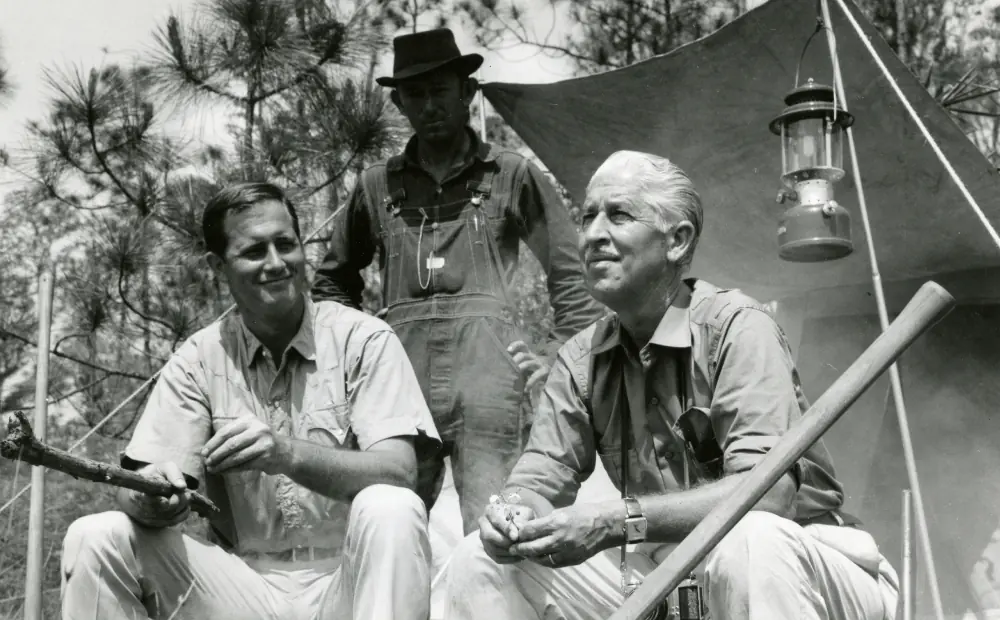0:02
When it comes to the critical mission of wildlife conservation, staying ahead of the curve is key to charting long term success.
0:10
As new challenges arise, so do new technologies and fresh ideas.
0:16
Today we're focusing on extraordinary forward thinkers around the nation who took experimental ideas and made them work for ecosystems and the amazing species in need of protection.
0:28
Our journey begins out West.
0:32
The Mojave Desert tortoise is threatened and being hunted by one of the most intelligent birds on our entire planet.
0:40
There's an emergency for tortoises that there's too many ravens.
0:45
Ravens are omnivores.
0:46
They eat everything.
0:48
Baby tortoises are a relatively easy snack.
0:52
In this nearby laboratory, Tim and his team of scientists are experimenting with high tech solutions to the problem.
1:00
Tim, I'm super interested in all of the different devices and models that are on this table.
1:06
First, I have to introduce you to Frank, Garcia Frank, resident genius 3D printing expert.
1:13
This is the culmination the result of about 10 years of development work.
1:18
OK, so what are these guys?
1:21
Well, that's a techno tortoise.
1:22
Whoa, what is a techno tortoise?
1:24
That's a 3D printed data acquisition tool.
1:27
So basically, it works like this.
1:29
We have a sensor inside the fake baby tortoise.
1:34
Raven starts tapping, and as soon as it hits it with a certain amount of force, we have it programmed to go poof.
1:44
The irritant we use is called methylanthranolate.
1:46
OK, wait, what is that?
1:48
It's grape juice.
1:49
It's fake grape juice.
1:50
Whoa.
1:51
For some reason.
1:52
I know this is weird.
1:53
For some reason it drives them crazy.
1:55
It's like pepper spray for birds.
1:57
Does it have long term impacts to the ravens or just irritates them for a couple minutes completely?
2:02
An organic material that dissipates just gets in their face.
2:06
It surprises the heck out of them.
2:10
How would you feel if you sat down to a nice plate of spaghetti and all of a sudden it went off in your face?
2:15
It would change your attitude towards spaghetti significantly.
2:19
If we can retrain them, they actually become allies.
2:24
A trained Raven, an educated raven influences the behavior of other ravens.
2:30
And they're very smart animals.
2:32
They're great students.
2:35
Solutions can come in many forms, especially when we challenge ourselves to innovate.
2:43
in Washington state, innovation and conservation has led to an important partnership with beavers.
2:51
Knowing on trees is, well, what beavers do.
2:54
In fact, it's their superpower.
2:57
They're the lumberjacks of the animal kingdom and can chew through a six inch trunk or a branch in just a few minutes.
3:06
They build dams to dam up water and to create habitat that they can swim around in, where they're safe from predators and they have access to their food.
3:17
And that dam, it's made out of sticks and stones and mud, and it starts to slow the water down and it spreads out over the landscape and it starts to sink into the soils and new vegetation starts to grow and it becomes this booming wetland.
3:33
Beavers were once incredibly common across North America.
3:37
It's estimated there were 400 million of them, and the landscape was much wetter.
3:44
But when Europeans arrived, beavers were ruthlessly haunted.
3:49
They were haunted primarily because of their fur, so they're worth their weight in gold, literally.
3:55
It was a easy way to get rich if you could go out and trap beaver.
4:00
The population of beavers crashed from around 400 million in North America down to the hundreds of thousands, so they were almost extinct on this continent.
4:08
We used to have so much more wetland in the West than we have right now.
4:12
We've lost somewhere between 70 and 90%, depending on what part of the West you're in.
4:17
Freshwater is an incredibly valuable resource for pretty much everything.
4:22
There's no water, there's no fish.
4:25
If there's no water, there's no food, there's nothing.
4:30
And we lost up to 100,000 square miles of wetlands as beavers were eliminated.
4:38
But a major conservation movement over the last century is making a difference.
4:46
People advocating for the beaver have allowed beavers to come back into some landscapes where they haven't been for about 100 years.
4:54
In the early 1980s, Marlin Perkins took viewers inside a beaver lodge to show the important role that beavers play in the ecosystem.
5:03
Welcome to Mutual of Omaha's Wild Kingdom.
5:07
One of the most fascinating stories of nature occurs in the area of a beaver pond.
5:14
Animals are attracted to the water dammed up by the beavers.
5:18
It's incredible how big of an influence a small number of beavers can have.
5:24
They'll build 10s of dams so they are easy partners for engineering these riverscapes to be a lot healthier.
5:31
Now, many communities are leaning on the beaver's natural ability to restore wetlands, and scientists have devised a clever way to give these ecosystem engineers a helping hand.












